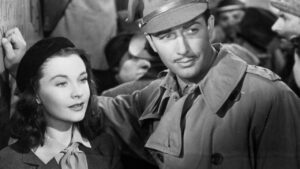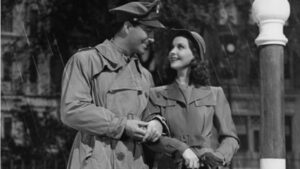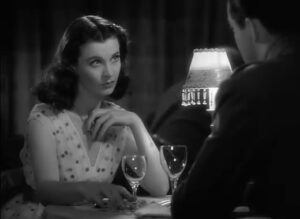“Waterloo Bridge” – Love and War

Title: “Waterloo Bridge”
Release Date: 1940
Director: Mervyn LeRoy
Cast: Vivien Leigh, Robert Taylor, Virginia Field, Marija Uspienska, Lucile Watson, C. Aubrey Smith
Vivien Leigh and Robert Taylor dancing to the nostalgic tune of “Waterloo Bridge” is one of the most memorable scenes in the history of cinema. In a moment they will be separated by the war and a dramatic, dignity-stripping struggle for survival. Nevertheless, the magic of the foreboding meeting and the dream of a life together that will never happen stay with the viewer until the end of the story, even 80 years after the premiere…
Mervyn LeRoy’s “Waterloo Bridge” was made in 1940. It was the beginning of a new era in cinema. The world was engulfed by the Great War, from which America still stayed away at the time, but the film slowly began to react to the events in Europe. LeRoy was one of the few directors who took up the subject of war before the involvement of the USA in the armed conflict. He decided to reach for the form of traditional melodrama, triumphant in the 1930s. And so he made a moving story about a British officer who, just before going to the front in 1939, stops at Waterloo Bridge, where he met and then lost the love of his life during the previous war.
Along with the protagonist, we go back in time and see how Roy Cronin (Robert Taylor) meets the beautiful ballerina Myra (Vivien Leigh) during one of his bombing raids. Despite extremely unfavorable circumstances, within hours the officer and the dancer fall in love with each other without memory and decide to get married. Just before the wedding, however, Roy is ordered to leave, and his beloved, in order to say goodbye to him, risks her job at the theater, for which she suffers a severe punishment. Together with a friend who tries to stand up for her, Myra is expelled from the ballet. The women struggle to cope with the reality of war. They cannot find employment and eventually starve to death. To make matters worse, on the day of a planned meeting with Roy’s mother, Myra finds his name in the newspaper in the column of the fallen. Desperate and destitute, Myra finally decides to become a prostitute. One day, looking for clients at the train station, she unexpectedly spots Cronin. It seems that Myra’s fate may change. The officer introduces her to his aristocratic family and gives a grand ball in honor of his beloved. However, Myra cannot bear the stigma weighing on her and decides to commit suicide…

“Waterloo Bridge” – a fallen girl and a flawless officer
In retrospect, “Waterloo Bridge” may evoke contradictory feelings. On the one hand, there is the perfectly conveyed heat of great love and the drama of the fallen girl – both situations perfectly played by the phenomenal Vivien Leigh and emphasized by the wonderful music. On the other hand, the contemporary viewer does not fully understand the moral burden of the heroine: it seems, after all, that her actions are fully absolved by the dramatic situation: the struggle for survival. So why can’t the woman just confide in Roy about her past? In a way, Myra’s dilemma is explained by Cronin’s high social standing. A prostitute in a snobbish lordly family, which, as Roy’s uncle prince states, even a relationship with a dancer is considered quite a misalliance, is rather poor wife material.
There is, however, something more here. It is an extremely traditionalist worldview, the most ardent guardian of which was the melodrama of the 1930s. In the film, this is accomplished through personal tragedy. Myra “must” commit suicide to restore the broken order.
Of course, there is a broader context here: “war takes away childhood,” as Roy philosophically states as he carries his beloved to his estate. War strips people of their illusions, tears down the fragile screen of culture, revealing the true, dark instincts. The war also leads to cultural changes, especially in the area of morality. It is no coincidence that after World War I, in most countries, women gained the right to vote.

Nevertheless, it is hard to resist the impression that in this story we find a clear disproportion between Myra’s guilt and Roy’s guilt. After all, a wealthy officer with a huge fortune does not care much about the fate of his fiancée during the war. Is he naïve? As an experienced soldier, does he not know how difficult it is for a young, single woman to survive in such difficult circumstances?
And that’s not all. Why is it that the film only makes us wonder about Myra’s misdeeds, and is completely silent on Roy’s actions? Could it be that fighting at the front produces only flawless heroes? Why can’t a man’s conscience and hands stained with blood prevent a happy ending of love? The answer to these questions makes the worldview of “Waterloo Bridge” anachronistic.
“Waterloo Bridge” – in a predatory female world
It would be unfair, nonetheless, to view Mervyn LeRoy’s “Waterloo Bridge” solely in terms of the contrast between the masculine and the feminine. It turns out that the world of the fair sex is not perfect at all. It is not populated only by noble characters like Myra and her friend Kitty (Virginia Field). It is worth noting here that Kitty constitutes a positive counterbalance to Roy’s passive and naive character. She does not hesitate to stand up for Myra, even at the cost of losing her job. She then nurses her friend through her illness and, in order to support her, decides to engage in prostitution. Kitty is an example of female solidarity, support and sacrifice, which the heroine, though beautiful and arousing desire, cannot seek from men.
Alongside Kitty, however, is Olga Kirova (Mariya Uspienska) – a vile and ruthless ballet owner who unscrupulously throws two defenseless girls into the street. Of course, one can see in her an envious old woman jealous of the beauty and success of the young girls. But one can also interpret this character in a completely different way: as the voice of reason. This is a woman who has achieved great success probably thanks to many sacrifices, free from the illusions of passion, which is why she warns Myra of the threat of her downfall.

An even more complex female character in “Waterloo Bridge” is Lady Margaret Cronin, Roy’s mother. On the one hand she seems unusually charming, wise and willing to forgive her son’s fiancée. Indeed, she even asks the girl herself for forgiveness. However, it is her omission that contributes to Myra’s downfall. Lady Margaret is a typical representative of her class, treated somewhat ironically in LeRoy’s film. The aristocracy appears here as a fossilized creation belonging to a bygone era. It pays homage to old customs, and its representatives’ mouths are full of good-natured platitudes, but that is usually all they end up with.
“Waterloo Bridge” – fatalistic circle of time
“Waterloo Bridge” brings a fatalistic vision of the world. We are dealing with the wheel of time: the constant return of wars, additionally emphasized by the same place where the events take place – Waterloo Bridge (the name itself also refers to the Napoleonic Wars). The looping space-time of the film puts human fate into a pessimistic context. Life is seen here as a continuous series of dramas, between which there is only a brief moment to take a breath – youth, love, dreams. What is more, the world splits here into two realities: the worlds of men and women, who are forced to fight for survival using the available methods.
In this sense, the eponymous Waterloo Bridge is a symbolic link between extremes: the masculine and the feminine, as well as the past and the future. The bridge, as an object inherently associated with travel, is also a sign of the transformation taking place – personal, but also historical and moral. In the fog of London Waterloo one cannot see what is on the other side (the film’s magnificent cinematography truly deserved an Oscar nomination). The bridge that rises above the changing waters of the river is, however, a sign of what is permanent – eternal partings with what is dearest to us and over which the nostalgic melody of the Farewell Waltz resounds.

